Students can Download Tamil Nadu 11th Economics Model Question Paper 4 English Medium Pdf, Tamil Nadu 11th Economics Model Question Papers helps you to revise the complete Tamilnadu State Board New Syllabus, helps students complete homework assignments and to score high marks in board exams.
TN State Board 11th Economics Model Question Paper 4 English Medium
General Instructions:
- The question paper comprises of four parts.
- You are to attempt all the parts. An internal choice of questions is provided wherever applicable.
- All questions of Part I, II, III and IV are to be attempted separately.
- Question numbers 1 to 20 in Part I are Multiple Choice Questions of one mark each.
These are to be answered by choosing the most suitable answer from the given four alternatives and writing the option code and the corresponding answer - Question numbers 21 to 30 in Part II are two-mark questions. These are to be answered in about one or two sentences.
- Question numbers 31 to 40 in Part III are three-mark questions. These are to be answered in above three to five short sentences.
- Question numbers 41 to 47 in Part IV are five-mark questions. These are to be answered in detail Draw diagrams wherever necessary.
Time: 3:00 Hours
Maximum Marks: 90
PART – I
Choose the correct answer. Answer all the questions: [20 × 1 = 20]
Question 1.
The cost incurred by producing one more unit of output is ……………………. cost.
(a) Variable
(b) Fixed
(c) Marginal
(d) Total
Answer:
(c) Marginal
![]()
Question 2.
Ordinal utility can be measured by ……………………
(a) Ranking
(b) Numbering
(c) Wording
(d) None of these
Answer:
(a) Ranking
Question 3.
A production function measures the relation between ……………………..
(a) Input prices and output prices
(b) Input prices and the quantity of output
(c) The quantity of inputs and the quantity of output
(d) The quantity of inputs and input prices
Answer:
(c) The quantity of inputs and the quantity of output
Question 4.
If average product is decreasing, then marginal product ……………………
(a) Must be greater than average product
(b) Must be less than average product
(c) Must be increasing
(d) Both (a) & (c)
Answer:
(b) Must be less than average product
![]()
Question 5.
Price discrimination will always lead to ………………………
(a) Increase in output
(b) Increase in profit
(c) Different prices
(d) (b) and (c)
Answer:
(d) (b) and (c)
Question 6.
Which of the following is a micro – economics statement?
(a) The real domestic output increased by 2.5 percent last year.
(b) Unemployment was 9.8 percent of the labour force last year.
(c) The price of wheat determines its demand
(d) The general price level increased by 4 percent last year.
Answer:
(c) The price of wheat determines its demand
![]()
Question 7.
The marginal productivity theory was developed by ……………………
(a) Clark
(b) Wickseed
(c) Walras
(d) All
Answer:
(c) Walras
Question 8.
The chief exponent of the cardinal utility approach was …………………..
(a) J.R. Hicks
(b) R.G. D. Allen
(c) Marshall
(d) Stigler
Answer:
(c) Marshall
![]()
Question 9.
Keynesian Theory of interest is popularly known as ……………………
(a) Abstinence theory
(b) Liquidity preference theory
(c) Loanable funds theory
(d) Agio theory
Answer:
(b) Liquidity preference theory
Question 10.
Total revenue is equal to total output sold multiplied by ………………….
(a) Price
(b) Total cost
(c) Marginal revenue
(d) Marginal cost
Answer:
(a) Price
![]()
Question 11.
In which of the following is not a type of market structure price will be very high?
(a) Perfect competition
(b) Monopoly
(c) Duopoly
(d) Oligopoly
Answer:
(b) Monopoly
Question 12.
The Father of Green Revolution in India was ……………………..
(a) M.S. Swaminathan
(b) Gandhi
(c) Visweswaraiah
(d) N.R. Viswanathan
Answer:
(a) M.S. Swaminathan
Question 13.
A Statement of equality between two quantities is called ……………………
(a) Inequality
(b) Equality
(c) Equations
(d) Functions
Answer:
(c) Equations
![]()
Question 14.
Product obtained from additional factors of production is terms as ………………….
(a) Marginal product
(b) Total product
(c) Average product
(d) Annual product
Answer:
(a) Marginal product
Question 15.
Rent is the reward for the use of ……………………..
(a) Capital
(b) Labour
(c) Land
(d) Organization
Answer:
(c) Land
Question 16.
Revenue received from the sale of additional unit is termed as …………………….. revenue.
(a) Profit
(b) Average
(c) Marginal
(d) Total
Answer:
(c) Marginal
![]()
Question 17.
Tamil Nadu is rich in ……………………
(a) Forest resource
(b) Human resource
(c) Mineral resource
(d) All the above
Answer:
(d) All the above
Question 18.
The New foreign trade policy was announced in the year ……………………….
(a) 2000
(b) 2002
(c) 2010
(d) 2015
Answer:
(a) 2000
![]()
Question 19.
The PQLI was developed by ……………………..
(a) Planning Commission
(b) Nehru
(c) Morris
(d) Morrisd.Biswajeet
Answer:
(c) Morris
Question 20.
In India’s total cement production, Tamil Nadu ranks ……………………….
(a) Third
(b) Fourth
(c) First
(d) Second
Answer:
(a) Third
PART – II
Answer any seven question in which Question No. 30 is compulsory. [7 × 2 = 14]
Question 21.
State the meaning of privatization?
Answer:
Privatization means transfer of ownership and management of enterprises from public sector to private sector.
![]()
Question 22.
What are the reasons for upward sloping supply curve?
Answer:
- A supply curve represents the data given in the supply schedule. As the price of the commodity increases, the quantum supplied of the commodity also increases. Thus the supply curve has a positive slope from left to right.
- The quantum supplied of commodity x is represented on X axis. And the price of the commodity is represented on the Y axis. The points such as e, d, c, b and a on the supply curve SS’, represent various quantities at different prices.
Question 23.
Give a short note on Sen’s “choice of Technique”?
Answer:
Sen’s “Choice of Technique” was a research work where he argued that in a labour surplus economy; generation of employment cannot be increased at the initial stage by the adaptation of capital – intensive technique.
![]()
Question 24.
What are major ports in Tamil Nadu?
Answer:
- Tamil Nadu has three major ports; one each at Chennai, Ennore, and Thoothukudi as well as one intermediate port in Nagpattinam, and 23 minor ports.
- All the minor ports are managed by the Tamil Nadu Maritime Board, Chennai Port.
- Ennore port was recently converted from an intermediate port to a major port and handles all the coal and ore traffic in Tamil Nadu.
![]()
Question 25.
Define cost function?
Answer:
The function relationship between cost and output is expressed as ‘Cost Function’.
A Cost Function may be written as
C = f(Q)
Eg. TC = Q3 – 18Q2 + 91Q + 12
Where, C = Cost and Q = Quantity of output. Cost functions are derived functions because they are derived from Production Functions.
Question 26.
What are the main menus of MS word?
Answer:
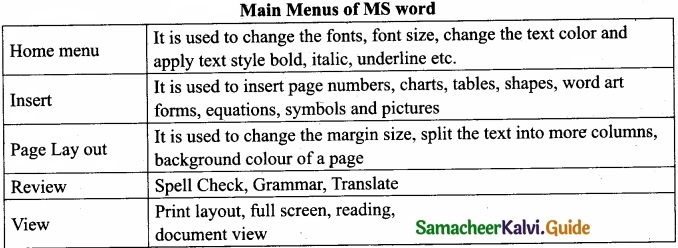
Where, C = Cost and Q = Quantity of output. Cost functions are derived functions because they are derived from Production Functions.
![]()
Question 27.
If 62 = 34 + 4 x what is x?
Answer:
62 – 34 = 4x ⇒ 28 = 4x
28 ÷ 5 – 4 = 1x
∴ x = 7
Question 28.
Define‘Rent’?
Answer:
Rent is the price or reward given for the use of land or house or a machine to the owner. But, in Economics, “Rent” or “Economic Rent” refers to that part of payment made by a tenant to his land lords for the use of land only.
![]()
Question 29.
What are conditions for producer’s equilibrium?
Answer:
- Producer equilibrium implies the situation where producer maximizes his output.
- It is also known as optimum combination of the factors of production.
- In short, the producer manufactures a given amount of output with ‘least cost combination of factors’, with his given budget.
Question 30.
Write three policy initiative introduced in 1991 – 92 to correct the fiscal imbalance?
Answer:
The important policy initiatives introduced in the budget for the year 1991 – 92 for correcting the fiscal imbalance were:
- Reduction in fertilizer subsidy.
- Abolition of subsidy on sugar.
- Disinvestment of a part of the government’s equity holdings in select public sector undertakings.
PART – III
Answer any seven question in which Question No. 40 is compulsory. [7 × 3 = 21]
Question 31.
Describe the performance of Tamil Nadu economy in health?
Answer:
- Tamil Nadu has a three – tier health infrastructure comprising hospitals, primary health centres, health units, community health centres and sub – centres.
- As of March 2015, the State had 34 district hospitals, 229 sub – divisional hospitals, 1,254 primary health centres, 7,555 sub – centres and 313 community health centres.
![]()
Question 32.
Explain the difference between internal and external economies?
Answer:
|
Internal Economies of Scale |
External Economies of Scale |
| 1. Expansion of the firm itself. | 1. Expansion of the industry. |
| 2. Lower long run average cost. | 2. Benefits most all firms. |
| 3. Efficiencies from larger scale production. | 3. Agglomeration economies are important. |
| 4. Range of economies (e.g.,) Technical and Financial. | 4. Helps to explain the rapid growth of many cities. |
Question 33.
State and explain the elasticity of supply?
Answer:
- Elasticity of supply may be defined as the degree of responsiveness of change in supply to change in price on the part of sellers.
- It is Mathematically expressed as,
Elasticity of supply = Proportionate change in supply / Proportionate change in price
es = \(\frac { \Delta Q_{ S } }{ Qs } \)/\(\frac { \Delta P }{ P } \)
es = \(\frac { \Delta Q_{ S } }{ \Delta P } \) × \(\frac { P }{ Q_{ S } } \)
Where Qs represents the supply, P represents price, ∆ denotes a change.
![]()
Question 34.
Write a note on mineral resources in TamilNadu?
Answer:
Mineral Resources in Tamil Nadu:
- Tamil Nadu has a few mining projects based on Titanium, Lignite, Magnesite, Graphite, Limestone, Granite and Bauxite.
- The first one is the Neyveli Lignite Corporation that has led development of large industrial complex around Neyveli in Cuddalore district with Thermal Power Plants, Fertilizer and Carbonisation plants.
- Magnesite mining is at Salem from which mining of Bauxite ores are carried out at Yercaud, and this region is also rich in iron ore at Kanjamalai.
- Molybdenum is found in Dharmapuri, and is the only source in the country.
Question 35.
What are the motives of demand for money?
Answer:
Motives of Demand for Money:
According to Keynes, there are three motives for liquidity preference. They are:
1. The Transaction Motive :
- The transaction motive relates to the desire of the people to hold cash for the current transactions.
- The amount saved under this motive depends on the level of income. Mt = f(y)
2. The Precautionary Motive:
- The precautionary motive relates to the desire of the people to hold cash to meet unexpected or unforeseen expenditures such as sickness, accidents, fire and theft.
- The amount saved for this motive also depends on the level of income. Mp – f(r)
3. The Speculative Motive:
The speculative motive relates to the desire of the people to hold cash in order to take advantage of market movements regarding the future changes in the price of bonds and securities in the capital market. The amount saved for this motive depends on the rate of interest.
MS = f(i). There is inverse relation between liquidity preference and rate of interest.
![]()
Question 36.
State Ambedkar’s Economic Ideas on agricultural economics?
Answer:
In the 1918, Ambedkar published a paper “Small Holding in India and their Remedies”. Citing Adam Smith’s “Wealth of Nations”, he made a fine distinction between “Consolidation of Holdings” and Enlargement of Holdings”.
Question 37.
What are the functions of Entrepreneur?
Answer:
Functions of an Entrepreneur:
- Initiation: An organizer is the initiator of the business, by considering the situation and availability of resources and planning the entire process of business of production.
- Innovation: A successful entrepreneur is always an innovator. He introduces new methods in the production process.
- Co – ordination: An organizer applies a particular combination of the factor of production to start and run the business or production.
- Control, Direction and Supervision: An organiser controls so that nothing prevents the organisation from achieving its goal. He directs the factors to get better results and supervises for the efficient functioning of all the factors involved in the process of production.
- Risk – taking and uncertainty – bearing: There are risk – taking and uncertainty-bearing obstacles. Risks may be insured but uncertainties cannot be insured. They reduce the profit.
![]()
Question 38.
Explain GSDP in Tamil Nadu?
Answer:
- The Gross State Domestic Product (GSDP) refers to the total money value of all the goods and services produced annually in the state.
- Tamil nadu is the second largest economy in India with a GSDP of $ 207.8 billion in 2016 – 2017 according to the Directorate of Economics and Statistics, Tamil Nadu.
- The GSDP of Tamil Nadu is equal to the GDP of Kuwait on nominal term and GDP of UAE on PPP terms. Per capita GSDP would be better for intercountry or interstate comparisons.
- Tamil Nadu GSDP = $207.8 billion in 2016 – 17.
Question 39.
Briefly explain the concept of consumer’s equilibrium?
Answer:
The consumer reaches equilibrium at the point where the budget line is tangent on the indifference curve. T is the point of equilibrium as budget line AB is tangent on indifference curve IC3 the upper IC which implies maximum possible level of satisfaction.
At equilibrium point, the slope of IC refers to MRSXY and the slope of BL (Budget Line) refers to ratio of price of X to price of Y i.e. Px / Py . Therefore MRSx,y = Px / Py.
![]()
Question 40.
List out the kinds of wages:
Answer:
Wages are divided into four types.
- Nominal Wages or Money Wages: Nominal wages are referred to the wages paid in terms of money.
- Real Wages: Real wages are the wages paid in terms of goods and services. Hence, real wages are the purchasing power of money wages.
- Piece Wages: Wages that are paid on the basis of quantum of work done.
- Time Wages: Wages that are paid on the basis of the amount of time that the worker works.
PART – IV
Answer all the questions. [7 × 5 = 35]
Question 41 (a).
Write a brief note on the Gandhian economic ideas?
Answer:
Gandhian Economics is based on ethical foundations. Gandhi wrote “ Economics that hurts the moral well-being of an individual or a nation is immoral, and therefore , Sinful”. Gandhi repeated the same belief “ that economy is untrue which ignores or disregards moral values”.
Salient features of Gandhian Economic Thought:
(I) Village Republics:
- India lives in villages.
- He was interested in developing the villages as self – sufficient units.
- He opposed extensive use of machinery, urbanization and industrialization.
(II) On Machinery:
- Gandhi described machinery as ‘Great sin’. He said that “Books could be written to demonstrate its evils”.
- It is necessary to realize that machinery is bad.
- Instead of welcoming machinery as a boon, we should look upon it as an evil.
- It would ultimately cease.
(III) Industrialism:
- Gandhi considered industrialism as a curse on mankind.
- He thought industrialism depended entirely on a country’s capacity to exploit.
(IV) Decentralization:
Gandhi advocated a decentralized economy i. e., production at a large number of places on a small scale or production in the people’s homes.
(V) Village Sarvodaya:
- According to Gandhi, “ Real India was to be found in villages and not in towns or cities”.
- He suggested, self – dependent villages.
(VI) Bread Labour:
- Gandhi realized the dignity of human labour.
- He believed that God created man to eat his bread by the sweat of his brow.
- Bread labour or body labour was the expression that Gandhi used to mean manual labour.
(VII) The Doctrine of Trusteeship:
Trusteeship provides a means of transforming the present capitalist order of society into an egalitarian one.
(VIII) On the Food Problem:
- Gandhi was against any sort of food controls.
- Once India was begging for food grain, but now India tops the world with very large production of food grains, fruits, vegetables, milk, egg, meat etc.
(IX) On Population:
- Gandhi opposed the method of population control through contraceptives.
- He was, however, in favour of birth control through Brahmacharya or self – control.
- He considered self – control as a sovereign remedy to the problem of Over population.
(X) On Prohibition:
- Gandhi regarded the use of liquor as a disease rather than a vice.
- He felt that it was better for India to be poor than to have thousands of drunkards.
- Many states depend on revenue from liquor sales.
[OR]
(b) Analyse the causes for Rural Indebtedness?
Answer:
The Causes for Rural Indebtedness:
(I) Poverty of Farmers:
- The vicious circle of poverty forces the farmers to borrow for consumption and cultivation.
- Thus poverty, debt and high rates of interest hold the farmer in the grip of money lenders.
(II) Failure of Monsoon:
- Frequent failure of monsoon is a curse to the farmers and they have to suffer due to the failure of nature.
- Farmers find it difficult to identify good years to repay their debts.
(III) Litigation:
- Due to land disputes litigation in the court compels them to borrow heavily.
- Being uneducated and ignorant they are caught in the litigation process and dry away their savings and resources.
(IV) Money Lenders and High Rate of Interest:
The rate of interest charged by the local money lenders is very high and the compounding of interest leads to perpetuate indebtedness of the farmer.
![]()
Question 42 (a).
Explain various divisions of Economics?
Answer:
Economics sub divisions are:
(I) Consumption:
- Human wants coming under consumption is the starting point of economic activity.
- In this section the characteristics of human wants based on the behaviour of the consumer, the diminishing marginal utility and consumer’s surplus are dealt with.
(II) Production:
- Production is the process of transformation of inputs into output.
- This division covers the characteristics and role of the factors of production namely land, labour, capital and organization.
(III) Exchange:
- Exchange is concerned with price determination in different market forms.
- This division covers trade and commerce.
- Consumption is possible only if the produced commodity is placed in the hands of the consumer.
(IV) Distribution:
- Production is the result of the coordination of factors of production.
- Since a commodity is produced with the efforts of land, labour, capital and organization, the produced wealth has to be distributed among the cooperating factors.
- The reward for factors of production is studied in this division under rent, wages, interest and profit.
- Distribution studies about the pricing of factors of production.
[OR]
(b) Explain the law of demand and its exceptions?
Answer:
Definitions:
The Law of Demand says as “the quantity demanded increases with a fall in price and diminishes with a rise in price”. – Marshall
“The Law of Demand states that people will buy more at lower price and buy less at higher prices, other things remaining the same”. – Samuelson Assumptions of Law of Demand:
- The income of the consumer remains constant.
- The taste, habit and preference of the consumer remain the same.
- The prices of other related goods should not change.
- There should be no substitutes for the commodity in study.
- The demand for the commodity must be continuous.
- There should not be any change in the quality of the commodity.
Given these assumptions, the law of demand operates. If there is change even in one of these assumptions, the law will not operate.
Explanation:
The law of demand explains the relationship between the price of a commodity and the quantity demanded of it. This law states that quantity demanded of a commodity expands with a fall in price and contracts with a rise in price.
In other words, a rise in price of a commodity is followed by a contraction demand and a fall in price is followed by extension in demand. Therefore, the law of demand states that there is an inverse relationship between the price and the quantity demanded of a commodity.
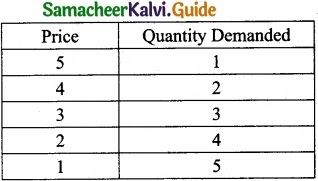
Exceptions to the law of demand:
Normally, the demand curve slopes downwards from left to right. But there are some unusual demand curves which do not obey the law and the reverse occurs.
A fall in price brings about a contraction of demand and a rise in price results in an extension of demand. Therefore the demand curve slopes upwards from left to right. It is known as exceptional demand curve.
In the above diagram, DD is the demand curve which slopes upwards from left to right. It shows that when price is OP1,, OQ1, is the demand and when the price rises to OP2, demand also extends to OQ2.
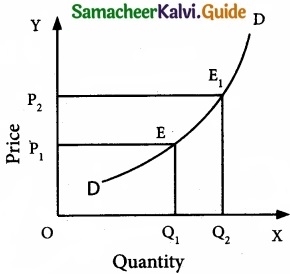
![]()
Question 43 (a).
Describe the degree of price discrimination?
Answer:
Degrees of Price Discrimination:
Price discrimination has become widespread in almost all monopoly markets. According to A.C.Pigou, there are three degrees of price discrimination.
(I) First degree price discrimination:
A monopolist charges the maximum price that a buyer is willing to pay. This is called as perfect price discrimination. This price wipes out the entire consumer’s surplus. This is maximum exploitation of consumers. Joan Robinson named it as “Perfect Discriminating Monopoly”.
(II) Second degree price discrimination:
Under this degree, buyers are charged prices in such a way that a part of their consumer’s surplus is taken away by the sellers. This is called as imperfect price discrimination. Joan Robinson named it as “Imperfect Discriminating Monopoly”.
Under this degree, buyers are divided into different groups and a different price is charged for each group. For example, in cinema theatres, prices are charged for same film show from viewers of different classes. In a theatre the difference between the first row of first class and the last row in the second class is smaller as compared to the differences in charges.
(III) Third degree price discrimination:
The monopolist splits the entire market into a few sub – market and charges different price in each sub – market. The groups are divided on the basis of age, sex and location. For example, railways charge lower fares from senior citizens. Students get discounts in museums, and exhibitions.
[OR]
(b) Write a short note on Total Revenue?
Answer:
Total revenue is the amount of income received by the firm from the sale of its products. It is obtained by multiplying the price of the commodity by the number of units sold.
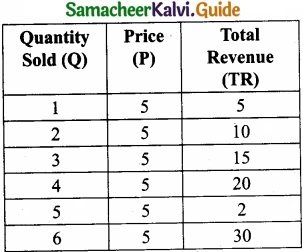
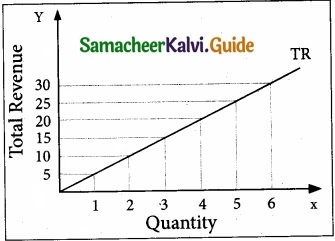
where, TR denotes Total Revenue, P denotes Price and Q denotes Quantity sold.
For example, a cell – phone company sold 100 cell – phones at the price of ₹500 each.
TR is ₹50,000. (TR = 500 × 100 = 50,000).
When price is constant, the behaviour of TR is shown in the above table and diagram, assuming P = 5. When P = 5; TR = PQ
When price is declining with increase in quantity sold. (Eg. Imperfect Competition on the goods market) the behaviour of TR is shown in the following table and diagram. TR can be obtained from Demand fuction: If Q = 11 – P,
When P = 1, Q = 10
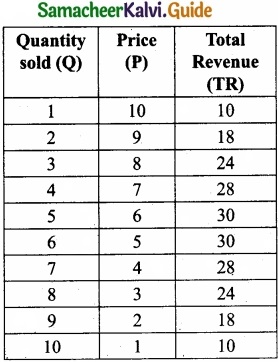
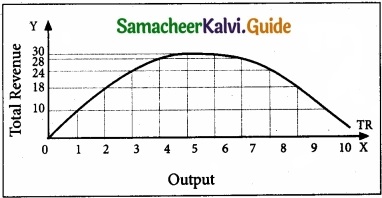
TR = PQ = 1 × 10 = 10
When P = 3, Q = 8, TR = 24
When P = 0, Q = 1, TR = 10
![]()
Question 44 (a).
Discuss the problems of Rural Economy?
Answer:
Rural areas are facing number of problems relating to,
- People
- Agriculture
- Infrastructure
- Economy
- Society and Culture
- Leadership and
- Administration.
(I) People Related Problems:
The problems related to individuals and their standard of living consist of illiteracy, lack of technical know how, low level of confidence, dependence on sentiments and beliefs etc.
(II) Agriculture Related Problems:
The problems related to agriculture include as follows,
- Lack of expected awareness, knowledge, skill and attitude.
- Unavailability of inputs.
- Poor marketing facility.
(III) Infrastructural Related problems:
Poor infrastructure facilities like, water, electricity, transport, educational institutions, communication, health, employment, storage facility, banking and insurance are found in rural areas.
(IV) Economics related problems:
The economic problems related to rural areas are,
- Inability to adopt high cost technology
- High cost of inputs
- Under privileged rural industries.
- Low income
- Indebtedness
- Existence of inequality in land holdings and assets
(V) Leadership Related Problems:
The Specific leadership related problems found in rural areas are:
- Leadership among the hands of inactive and incompetent people
- Self – interest of leaders
- Biased political will
- Less bargaining power
- Negation skills and dominance of political leaders
(VI) Administrative Problems:
The rural administrative problems are,
- Political interference
- Lack of motivation and interest
- Low wages in villages
- Improper utilization of budget
- Absence of monitoring
- Implementation of rural development programme.
[OR]
(b) Mention the causes for Rural poverty?
Answer:
Causes for Rural Poverty:
1. Unequal distribution of Land:
The distribution of land is highly skewed in rural areas. Therefore, majority of rural people work as hired labour to support their families.
2. Lack of Non – Farm Employment:
Non – farm employment opportunities do not match the increasing labour force. The excess supply of labour in rural areas reduces the wages and increases the incidence of poverty.
3. Lack of public sector Investment:
The root cause of rural poverty in our country is lack of public sector investment on human resource development.
4. Inflation:
Steady increase in prices affects the purchasing power of the rural poor leading to rural poverty.
5. Low productivity:
Low productivity of rural labour and farm activities is a cause as well as the effect of poverty.
6. Unequal Benefit of Growth:
Major gains of economic development are enjoyed by the urban rich people leading to concentration of wealth. Due to defective economic structure and policies, gains of growth are not reaching the poor and the contributions of poor people are not accounted properly.
7. Low Rate of Economic Growth:
The rate of growth of India is always below the target and it has benefited the rich. The poor are always denied of the benefits of the achieved growth and development of the country.
8. More Emphasis on Large Industries:
Huge investment in large industries catering to the needs of middle and upper classes in urban areas are made in India. Such industries are capital-intensive and do not generate more employment opportunities. Therefore, poor are not in a position to get employed and to come out from the poverty in villages.
9. Social evils:
Social evils prevalent in the society like custom, beliefs, etc., increase unproductive expenditure.
![]()
Question 45 (a).
Bring out the relationship between TR, AR, MR and Elasticity of demand?
Answer:
Relationship among TR, AR and MR Curves:
When marginal revenue is positive, total revenue rises, when MR is zero the total revenue becomes maximum. When marginal revenue becomes negative total revenue starts falling. When AR and MR both are falling, then MR falls at a faster rate than AR.
TR, AR, MR and Elasticity of demand:
- The relationship among AR, MR and elasticity of demand (e) is stated as follows.
MR = AR (e – 1/e) - The relationship between The AR curve and MR curve depends upon the elasticity of AR curve [AR = DD = Price]
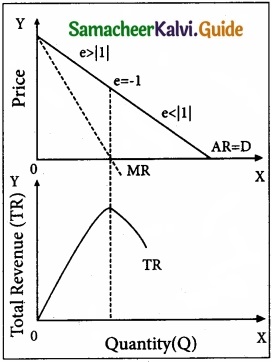
- When price elasticity of demand is greater than one, MR is positive and TR is increasing.
- When price elasticity of demand is less than one, MR is negative and TR is decreasing.
- When price elasticity of demand is equal to one, MR is equal to Zero and TR is maximum and constant.
It is to be noted that, the output range of 1 to 5 units, the price elasticity of demand is greater than one according to total outlay method. Hence, TR is increasing and MR is positive.
TR, AR, MR & Elasticity
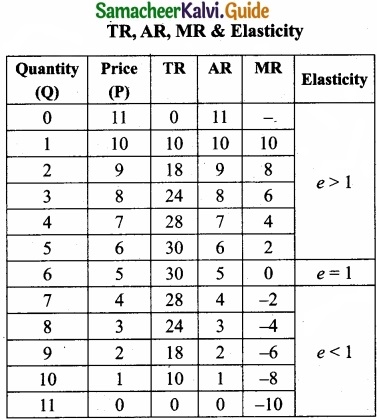
At the output range of 5 to 6 units, the price elasticity of demand is equal to one. Hence, TR is maximum and MR is equals to zero. At the output range of 6 units to 10 units, the price elasticity of demand is less than unity. Hence, TR is decreasing and MR is negative.
[OR]
(b) Explain the monetary and financial sector reforms?
Answer:
Monetary reforms aimed at doing away with interest rate distortions and rationalizing the structure of lending rates. The new policy tried in many ways to make the banking system more efficient. Some of the measures undertaken were:
(I) Reserve Requirements:
- Reduction in Statutory liquidity ratio [SLR] and the cash reserve ratio [CRR] were the recommendations by the Narasimham Committee Report, 1991.
- It was proposed to cut down the SLR from 38.5 percent to 25 percent within a time span of three years.
(II) Interest Rate Liberalisation:
RBI controlled:
- The interest rates payable on deposits. The interest rate which could be charged for bank loans.
- Greater competition among public sector, private sector and foreign banks and elimination of administrative constraints.
- Liberalisation of bank branch licensing policy in order to rationalize the existing branch network.
- Banks were given freedom to relocate branches and open specialized branches.
- Guidelines for opening new private sector banks.
- New accounting norms regarding classification of. assets and provisions of bad debt were introduced in tune with the Narasimham Committee Report.
![]()
Question 46 (a).
Examine the law of variable proportions with the help of a diagram?
Answer:
The law states that if all other factors are fixed and one input is varied in the short run, the total output will increase at an increasing rate at first instance^ be constant at a point and then eventually decrease. Marginal product will become negative at last.
According to G.Stigler, “As equal increments of one input are added, the inputs of other productive services being held constant, beyond a certain point, the resulting increments of product will decrease, i.e., the marginal product will diminish”.
Assumptions:
The Law of Variable Proportions is based on the following assumptions.
- Only one factor is variable while others are held constant.
- All units of the variable factor are homogeneous.
- The product is measured in physical units.
- There is no change in the state of technology.
- There is no change in the price of the product.
Total Product (TP)
Total product refers to the total amount of commodity produced by the combination of all inputs in a given period of time.
Summation of marginal products, i.e.
TP = ΣMP
where, TP = Total Product,
MP = Marginal Product
Average Product (AP)
Average Product is the result of the total product divided by the total units of the input employed. In other words, it refers to the output per unit of the input.
Mathematically, AP = TP/N
Where, AP = Average Product
TP = Total Product
N = Total units of inputs employed
Marginal Product (MP)
Marginal Product is the addition or the increment made to the total product when one more unit of the variable input is employed. In other words, it is the ratio of the change in the total product to the change in the units of the input. It is expressed as
MP = ∆TP/∆N
where,
MP = Marginal Product
∆TP = Change in total product
∆N = Change in units of input It is also expressed as
MP = TP(n) – TP (n – 1)
Where, MP = Marginal Product
TP(n) = Total product of employing nth unit of a factor.
TP(n – 1) = Total product of employing the previous unit of a factor, that is, (n – 1)th unit of a factor.
The Law of Variable Proportions is explained with the help of the following schedule and diagram:
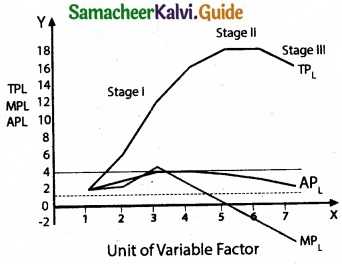
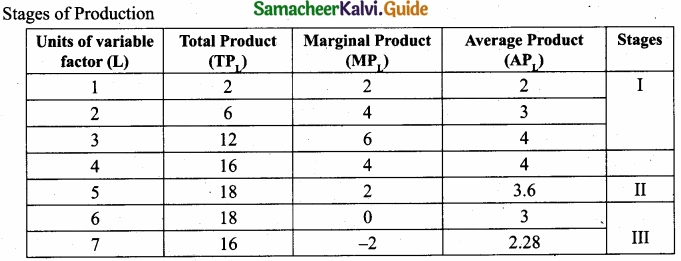
In above table, units of variable factor (labour) are employed along with other fixed factors of production. The table illustrates that there are three stages of production. Though total product increases steadily at first instant, constant at the maximum point and then diminishes, it is always positive forever.
While total product increases, marginal product increases up to a point and then decreases. Total product increases up to the point where the marginal product is zero. When total product tends to diminish marginal product becomes negative.
In diagram, the number of workers is measured on X axis while TPL, APL and MPL are denoted on Y axis. The diagram explains the three stages of production as given in the above table.
Stage I:
In the first stage MPL increases up to third labourer and it is higher than the average product, so that total product is increasing at an increasing rate. The tendency of total product to increase at an increasing rate stops at the point A and it begins to increase at a decreasing rate. This point is known as ‘Point of Inflexion’.
Stage II:
In the second stage, MPL decreases up to sixth unit of labour where MPL curve intersects the X – axis. At fourth unit of labor MPL = APL. After this, MPL curve is lower than the APL. TPL increases at a decreasing rate.
Stage III:
Third stage of production shows that the sixth unit of labour is marked by negative MPL, the APL continues to fall but remains positive. After the sixth unit, TPL declines with the employment of more units of variable factor, labour.
[OR]
(b) What are the types of elasticity of supply?
Answer:
There are five types of elasticity of supply
1. Relatively Elastic Supply:
The co – efficient of elastic supply is greater than 1 [ES > 1], One percent change in the price of a commodity causes more than one percent change in the quantity supplied of the commodity.
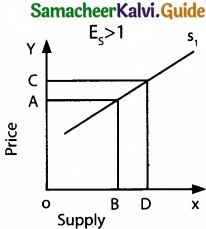
2. Unitary Elastic Supply:
The co – efficient of elastic supply is equal to 1 [Eg = 1]. One percent change in the price of a commodity causes an equal [one percent ] change in the quantity supplied of the commodity.
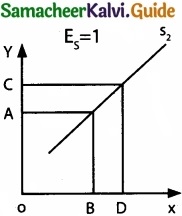
3. Relatively Inelastic Supply:
The co-efficient of elasticity is less than one [ES < 1]. One percent change in the price of a commodity causes and less than one percent change in the quantity supply supplied of the commodity.
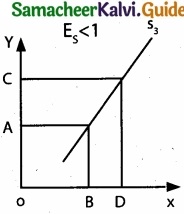
4. Perfectly Inelastic Supply:
The co – efficient of elasticity is equal to zero [ES = 0], One percent change in the price of a commodity causes no change in the quantity supplied of the commodity.
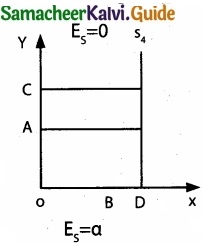
5. Perfectly Elastic Supply:
The co – efficient of elasticity of supply is infinity [ES = 3]. One percent change in the price of a commodity causes an infinite change in the quantity supplied of the commodity.
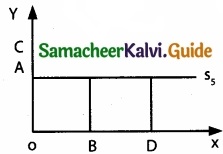
![]()
Question 47 (a).
Analyse the causes for Rural Indebtedness?
Answer:
The Causes for Rural Indebtedness:
(I) Poverty of Farmers:
- The vicious circle of poverty forces the farmers to borrow for consumption and cultivation.
- Thus poverty, debt and high rates of interest hold the farmer in the grip of money lenders.
(II) Failure of Monsoon:
- Frequent failure of monsoon is a curse to the farmers and they have to suffer due to the failure of nature.
- Farmers find it difficult to identify good years to repay their debts.
(III) Litigation:
- Due to land disputes litigation in the court compels them to borrow heavily.
- Being uneducated and ignorant they are caught in the litigation process and dry away their savings and resources.
(IV) Money Lenders and High Rate of Interest:
The rate of interest charged by the local money lenders is very high and the compounding of interest leads to perpetuate indebtedness of the farmer.
[OR]
(b) Explain the public transport system in Tamil Nadu?
Answer:
Transport:
Tamil Nadu has a well established transportation system that connects all parts of the State. This is partly responsible for the investment in the State.
Tamil Nadu is served by an extensive road network in terms of its spread and quality, providing links between urban centres, agricultural market-places and rural habitations in the countryside. However, there is scope for improvement.
Road Transport:
- There are 28 national highways in the State covering a total distance of 5,036 km.
- The State has a total road length of 167,000 km, of which 60,628 km are maintained by Highways Department.
Rail Transport:
- Tamil Nadu has a well-developed rail network as part of Southern Railway, Head quartered at Chennai.
- Tamil Nadu has a total railway track length of 6,693 km and there are 690 railway stations in the State.
- Main rail junctions in the State include Chennai, Coimbatore, Erode, Madurai, Salem, Tiruchirapalli and Tirunelveli.
- Chennai has a well – established suburban Railway network, a Mass Rapid Transport system and is currently developing a Metro System, with its first underground stretch operational since May 2017.
Air Transport:
- Tamil Nadu has four major international airports.
- Chennai International Airport is currently the third largest airport in India.
- Other international Airports in Tamil Nadu include Coimbatore International Airports, Madurai International Airport and Tiruchirapalli International Airport.
- It also has domestic airports at Tuticorin, Salem, and Madurai.
- Increased industrial activity has given rise to an increase in passenger traffic as well as freight movement which has been growing at over 18% per year.
Ports:
- Tamil Nadu has three major ports; one each at Chennai, Ennore and Tuticorin, as well as one intermediate port in Nagapattinam, and 23 minor ports.
- The ports are currently capable of handling over 73 million metric tonnes of cargo annually (24 % share of India).
- All the minor ports are managed by the Tamil Nadu Maritime Board, Chennai Port.
- This is an artificial harbour and the second principal port in the country for handling containers.
- It is currently being upgraded to have a dedicated terminal for cars capable of handling 4,00,000 vehicles.
- Ennore port was recently converted from an intermediate port to a major port and handles all the coal and ore traffic in Tamil Nadu.